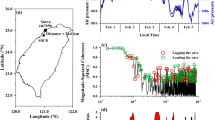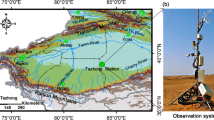Abstract
MEASUREMENTS of the height of the base of the aurora in northern Norway by C. Störmer (Geofys. Publ., I., No. 5) and by L. Vegard and O. Krogness (Geofys. Publ., I., No. 1) show that a considerable number of the bases are situated at heights of about 100 km. and about 106 km. (compare the frequency curve, Fig. 18, Geofys. Publ., I., No. 1, p. 101). In treating 1737 base-heights between 90 and 120 km. it was found from the frequency curve that during ebb-tide in the atmosphere the maximum at 100 km. was predominant, while during flood-tide the maximum at 106 km. was predominant. Further investigations have shown that the maxima of the frequency curve are to be considered as displacements of one and the same maximum. From this we conclude that, as regards the locality considered, the mass of air situated above 100 km. at ebb-tide is the same as the mass of air situated above 106 km. at flood-tide.
This is a preview of subscription content, access via your institution
Access options
Subscribe to this journal
Receive 51 print issues and online access
$199.00 per year
only $3.90 per issue
Buy this article
- Purchase on Springer Link
- Instant access to full article PDF
Prices may be subject to local taxes which are calculated during checkout
Similar content being viewed by others
Author information
Authors and Affiliations
Rights and permissions
About this article
Cite this article
EGEDAL, J. Variation of Conductivity of the Upper Atmosphere. Nature 123, 642–643 (1929). https://doi.org/10.1038/123642b0
Issue Date:
DOI: https://doi.org/10.1038/123642b0
Comments
By submitting a comment you agree to abide by our Terms and Community Guidelines. If you find something abusive or that does not comply with our terms or guidelines please flag it as inappropriate.



